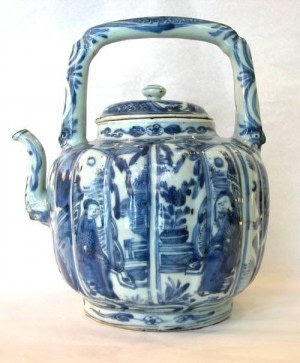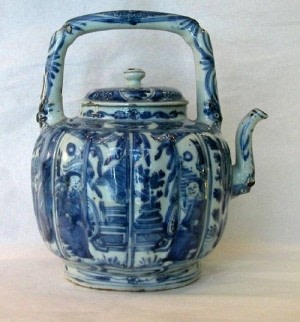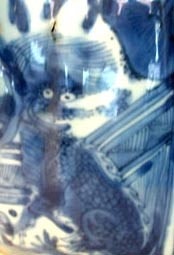Further images
Of lobed form with stiff upright handle and S shaped spout, the ovoid body with eight panels, each panel further divided into two fluted and moulded sections, all with exquisitely etched scenes as follows (from spout going to the right):-
(1) a seated qilin or fantastic fire-breathing animal, with cloven hooves and flying mane, its scaly body finely delineated, its eyes bulging, its mouth open, the tongue protruding from its fangs;
(2) & (3) two scenes using the lady on the terrace motif, one lady facing rightwards, one lady facing leftwards, the latter seated by a magnificent urn containing a flowering chrysanthemum, with, above her, a brush pot, suggestive of the scholarly pursuits so admired by the Chinese, each garden scene slightly different, but with the same motifs, a sun, sprouting grasses or plants, the ladies with elegantly draped clothes, holding brocaded cushions;
(4) a panel containing a magnificent chrysanthemum spray;
(5) a further seated with an amusing boisterous qilin;
(6) & (7) two identical further scenes using the lady on the terrace motif;
(8) a further panel containing a chrysanthemum spray;
the shoulder with a border of cross hatch work with two cartouches containing flowerheads, below a neck with with a spray of beribboned flowerheads, the cover with matching cross hatch ground and four cartouches containing flowerheads, an unusual open-work finial picking up the crosshatch design, the S shaped spout placed in line with the almost square handles, the handle ends and the base of the spout each with an vigorously painted monster head (or tao tieh mask).
Period: Ming Dynasty (between 1590 and 1625)
Literature
It is most unusual to have the body composed of sixteen lobes, divided into eight panels of two lobes each. Most wine kettles have six lobed panels.
For more about wine pots, see Rinaldi, Kraak Porcelain:. A Moment in the History of Trade, Bamboo Publishing London 1965, page 182-3 and plates 235 to 237. Krahl refers to the Witte Leeuw, where seven such winepots wer recovered subsequently from the wreck. See particularly, plate 237 which has the lady in the terrace motif alternating with the chrysanthemum sprays. Rinaldi points out (and we quote): ..that the decoration is not painted in the usual Kraak style (thin dark outline filled with a light wash); here the drawing is finely etched and the chiaroscuro effect is obtained with closely-drawn lines and not with dots (Plate 236). This technique is rare in Kraak wares.
See also Chinese Ceramics in the Collection of the Rijksmuseum, Amsterdam: The Ming and The Qing Dynasties, Prof. Christiaan J.A. Jorg in collaboration with Jan van Campen,, London 1997 Philip Wilson in association with the Rijksmuseum, Amsterdam, page 69 plates 56 & 57. Kraak kettles, writes Jorg, vary little in decoration, a design of flowers and auspicious symbols being the most common. The lady on the terrace motif is an interesting variant, since human figures seldom occur in Kraak porcelain decoration. It might be related to the design on the bowl Cat. No 47. Lunsingh Scheuleer illustrates a rare variant with a seated qilin.
Ours is just such a one. Already in the rare category, with the Lady on the terrace motif, the tao tieh masks on and handle and spout terminals make ours very unusual indeed. Most interesting of all is that ours has 16 lobes, divided into 8 panels of two lobes each.
(Lunsingh Scheurleer, D.F. Chine de Commande, London 1974, English translation of the Dutch edition, Hilversum 1966.)






